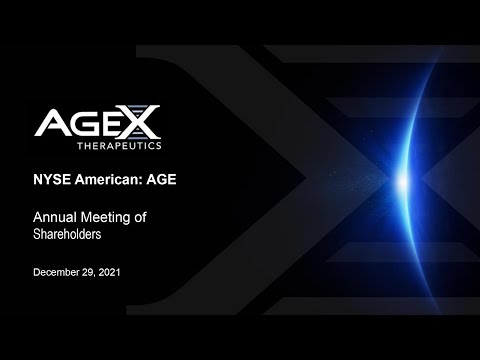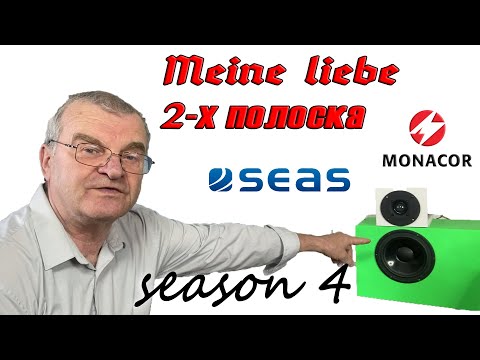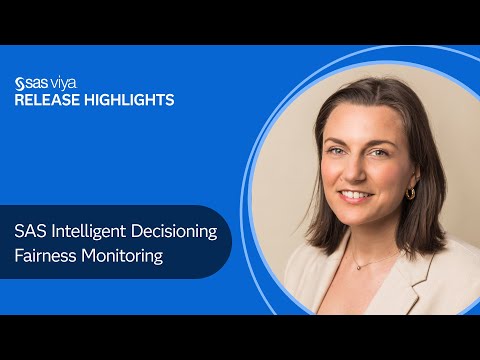AgeX 2021 Corporate Update

thank you the case before you do the piece before you do let me um point out to those listening that the um presentation can be found under documents in the top left hand side of the page and i'll walk you through the page number of the of the slide numbers so if you click on documents you'll see first the cover slide and then forward-looking statements so in in this today's presentation we'll be making certain forward-looking statements that have associated risks and uncertainties and so we refer you to our filings with the securities exchange commission for more detailed information about ajax and its subsidiaries including reverse uh slide three you know the mission of the company is as it always has been to target the rapidly growing markets in age-related degenerative disease we're doing that with this twin approach of the use of regenerative cells to regenerate tissue function and this new technology itr which will be the bulk of today's presentation on the cell therapy program said dr nephew now give us an update on peace us through it could the thanks mike uh good day shareholders uh i'm the feast malik the chief operating officer of ajax uh it's a pleasure to be speaking uh with you today i will take you through some of ajax's plans to evolve its business over the next year as cellular tissue regeneration therapies come of age investors and scientists are now excited about these therapies and we believe ajax is very well positioned with his ip and knowledge this year ajax has had success with this collaboration and licensing strategy which began 2020. i'd like to highlight a couple of things for 2021 firstly aj entered into a research collaboration with dr christian stanford of ohio state university she's one of the world's leading researchers in the transportation of brown advanced tissue or back in three clinical mouse models we are currently working with her to generate proof of concept for ajax patch one age expat one is a potential cell therapy candidate for diabetes and obesity the loss of non-shivering thermogenic fat also known as brown or good fat in humans is with ages associated with diabetes tied to diabetes and cardiovascular disease the mice that is performed by dr stanford are evaluated if transplantation of age expat one in mice improves diet induced obesity metabolic health including glucose metabolism and cardiac function she has now performed the first ajax that one transplant in mice and we should have data we can share next year in 2022 secondly ajax licensee instant biotechnology a biopharma company developing human embryonic stem cell derived messenger stem cells dose its first us multiple sclerosis patients with detained the esopharymal stem cell investigation or drug candidate ims001 at the shepherd center in atlanta imf001 was derived by iem stem from ajax's pluripotent stem cell line designated esi 053 under a non-exclusive sub license from ajax if in terms ims001 is in an early stage human clinical trial and in the future ajax will be entitled to see revenues in the form of royalties on the sale of imf001 if successfully developed by im stem and approved for marketing by the fda or foreign regulatory authorities additionally ajax will share certain other revenues that im stem may receive in connection with the development or commercialization of imf-001 in multiple sclerosis thirdly this past month ages entered into a research collaboration with the university of california irvine to explore the therapeutic potential of exosomes and other extracellular v squares produced by neural stem cells derived from ajax peru protein stem cells with the goal of developing therapies to treat adverse neurocognitive effects of cancer chemotherapy and radiation therapy on brain function this research project seeks to address a critical unmet medical needs that impacts the quality of life for millions of cancer survivors research will be conducted at uci under the direction of dr acharya who is associate professor at the uci stem cell research center this collaboration includes an opportunity for ajax to license innovations and inventions that may arise from the research program and to pursue clinical development and commercialization of therapies drive using those licensed inventions exosomes are a highly attractive area to be right now looking forward in 2022 ajax will be expanding its collaboration and licensing model even further with the aim of placing its iep for project candidates and technologies into ajax subsidiaries with value-add partners providing financing and potential co-development assistance the plan is for these subsidiaries to be independently financed diversifying sources of financing for ajax technologies and project handling candidates may permit agents to move a greater number of project development programs forward simultaneously dr stanford at ohio state university is performing a proof of concept mastery for ajax patch one which is being sponsored by ajax and if this is successful we may have the opportunity for a third potential subsidiary that would focus on developing age expats one and the option for diabetes and it's about in addition to this we also plan to seek out strategic options of ajax's universidade ajax fast one and pure stem over the course of next year we are also exploring other ways in which we might acquire and code available licensed technologies that will lead to the development of innovative cell therapies the ajax team is very much looking forward to 2022 as an opportunity to move multiple cellular therapies towards the clinic cellular therapies are coming of age now and it is the right time for asia to exploit the foundation it is created in tissue and cellular engineering and with that i hand back over to mike thank you for that update um so if you follow along with me on the slide deck there on the left hand part of your screen let's move to slide five um so that's we're going to be talking now about uh the subsidiary of ajax called reverse and we'll be describing our our uh what is currently ajax uh technology but what we would which we plan to have developed and commercialized through our subsidiary reverse so reverse's mission is to lead in the application of cell age reprogramming technology to precisely regulate induced tissue regeneration and cancer therapy so if we unpack that statement it's actually there's a lot of detail there reprogramming cell age is actually possible today i'm going to walk you through some of the the nuts and bolts of that the basics of how that's actually true and then um how we pres we have a technology to precisely regulate this age reversal to induce tissue regeneration something that as far as we know is a proprietary technology to our company and and then i'm going to describe in a bit more detail than we ever have before the profound cancer therapy implications of this and um i i'm just frankly amazed at how powerful this technology platform is uh broadly affecting diverse types of tissue regeneration potentially and diverse types of cancer i'm quite excited about this so let me quickly walk you through some of the science and some of our plans so if you follow along slide six the opportunity is obviously aging and age-related degenerative disease i don't need to belabor the point i don't think slide seven shows the u.s census bureau data and you'll see at 2020 we hit this inflection point where this tsunami of aging is hitting the shores of the united states and many other countries around the world and as i've said on many occasions some eighty percent of the health care costs uh the united states is due to chronic disease you know where the body cannot heal itself like in stroke or heart failure or osteoarthritis for example aging commonly has one or even more more than one chronic degenerative disease and this is what causes the vast majority of healthcare costs so this there's a huge unmet need to find a way to regenerate tissues that are reflected with chronic degenerative diseases especially in the case of aging and that's exactly what itr is all about these new technologies are transformational in scope and exciting as it can possibly be and the next slide nine uh it probably illustrates how thoughtful people are seeing this as a transformative technology for medicine here are just some you know news reports and scientific papers uh the left is jeff bezos who invested in this company altos lab some 270 million is a startup company in the space calico as i mentioned google's company and a publication below calico's logo there that they published in this space in the middle of the diagram is the harvard paper it got the cover of nature magazine which is one of the leading scientific journals in the world uh turning back time in retina to induce regeneration in the retina and then you can see also papers and other companies being launched in this space i think it's unprecedented in my experience such a powerful start for an entirely new technology platform and i think that reflects how thoughtful people see this as uh as about as profound a new technologies you can imagine okay let's get into a little bit of the nuts and bolts and how this works slide 10. so the red arrow illustrates the fact that our germline cells our reproductive cells continue the species forever but there's a fundamental difference in virtually all if not all of the cells in our body other than those reproductive cells the cells that branch out to make the skin and blood cells and bone cells and neurons and so on those are all called somatic cell types and they undergo a restriction or a loss of potential and that leads to aging and age-related degenerative disease and i'm going to walk you through how we over the years dissected out how this works and how we can intervene in it the next slide 11 shows the first step in this restriction this was work that i and others did way back when my first company geron we discovered that the who found the gene telomerase and patented it and showed that the loss of that gene causes the shortening of telomeres which is a clock of cell aging so cells somatic cells in our body have a finite capacity to divide it's called the hayflick limit and telomerase is an immortalizing enzyme and it's present in the germ line it allows cells to replicate well in case of our germline for billions of years so that's the first step the loss of telomerase activity and then um at my prayer company now called lineage i my colleagues here at ajax and in the future reverse showed that it was possible to completely reverse the aging of cells all the way back to the beginning of life in what are called ips cells using a combination of reprogramming factors i'm showing you some of them there sex 2 and 28 and so on and reset the lifespan of cells slide 13 shows how scientists look at telomeres those black splotches there on the left are one way of measuring telomere lengths and we showed that the we could take cells all the way back to the beginning of life and reverse as we said developmental aging and resource restore the cells back to the immortality of the germline and that was the beginning of itr actually 2010 on the right you can see subsequent work by steve horvath showing another kind of clock of aging it's called the dna methylation clock that it was that ips reprogramming these factors could reverse aging of that clock as well and i think the consensus today in the scientific community is the these genes can reverse the aging of cells in essentially every known aspect slide 14 the second step that somatic cells lose that causes chronic degenerative disease is the ability to regenerate in the first eight weeks or so the human body can regenerate profoundly but we lose that capacity and so now and as an adult if you have a heart attack your heart just scars over rather than grows back or cells in your midbrain lead to parkinson's disease they cannot repair themselves if you have a stroke you've lost your neurons forever and they can't grow back and so on well that we call that the uh eft embryonic fetal transition occurs around eight weeks of development animals slide 15 that can retain that regenerative state as adults regenerate profoundly so here on the left is a picture of the mexican salamander then the right if we had a video playing you'd see the amputated limb grow back in all of its complexity nearly perfectly and it's not just the limbs in these salamanders their brain can regenerate their hearts can regenerate that's an example of nature of what we want to do in human medicine we want to reawaken that biology in the human it's we call it induced tissue regeneration or itr and i think you can imagine how powerful that would be if we can implement this and bring this to the patient's bedside slide 16 shows you diagrammatically how that would happen we would apply these reprogramming factors i mentioned earlier but transiently express them to take cells back past that embryonic fetal transition eft to induce tissue regeneration but not take cells all the way back to the beginning of life so sort of take the train part way to your destination some people call this partial reprogramming so if you look on the internet and search the search term partial reprogramming in aging you'll probably find uh papers have been published in the space we call this itr it's essentially the same thing so slide 17 makes the point that our bodies early on are highly regenerative because they're under construction and as adults we lose that and itr is designed to bring in again the construction crew to allow the body to repair itself but the point at the top of the slide says itr is pan tissue as far as we know the mechanisms that turn off regeneration are common throughout the body throughout the different cell types of the body in the brain in bone and cartilage and muscle and the heart muscle in kidney and so on and so that's what makes this platform particularly attractive uh to us slide 18 shows just an example from our labs on hair regeneration using some of the technology our rtr technologies on the top left you can see the control animal and a combination of genes leading to complete regrowth of the hair in this animal on these representative pictures from our study slide 19 makes the point about one of our patent families relates to a new way of precisely regulating this process we do not want to overly reprogram cells we don't want to take cells all the way back to pluripotency we want to take them just past this eft and here is some an example using a viral vector on the left and then in in that vector would be dna shown on the right top and where we have these genes that can take cells like a time machine back in time and the switch that controls the genes we've chosen a proprietary gene promoter or switch that will be on when the cells are in the non-regenerative state that's the point of trying to make with the on the right in the middle where it says stop when eft is reached these vectors are designed to stop reprogramming once regeneration is induced and before the cells are taken all the way back to pluripotency we call this developmentally regulated itr or dritr and it's the subject of one of our patent families i have not heard of any of our competition uh inventing such a technology of course i'm not completely aware of everything that they're doing slide 20 uh rna or dna or all packaging are rna dna systems and then low source or data that the body body uses images uh like 21.
i you see this is coin flicker on the left aging and cancer have always been yin and yang and the minds of gerontologists so now we think we know why cancer utilizes some of these pathways uh in in cancer biology so the if you look in the middle of this page 21 you see cells and this is meant to be a cartoon so to speak or diagram illustrating the origins of a cancer so here we have cells that are hyper proliferating when they shouldn't be and what we have discovered well let me start with what the scientific community knows the can the scientific community knows that there's some cells that resist being destroyed by chemo or radiotherapy and they call those cancer stem cells and the current consensus in oncology is that those cells are of stem cell they're more primitive i have a red x through that we believe that's absolutely backwards we've discovered that the cancer stem cell is actually of what's called a cancer stem cell these residual cells that are not killed by radio chemo are actually the adult like cell and that cancers cells other than those have reverted back before the embryonic fetal transition this is a pre we believe is a previously unknown hallmark of cancers plural like itr addressing multiple tissue types in the body we believe this unique signature that we were hallmark that we discovered for cancer is common to virtually all cancers even lymphomas so gliomas sarcomas of various kinds carcinomas breast cancer colon cancer and lung cancer and so on so like telomerase it's a pan cancer hallmark and we have filed multiple patents on this because we believe this is a really important new insight into cancer and leads directly to novel diagnostic and therapeutic strategies slide 22 shows very briefly an example one of those therapeutic strategies which we've invented and filed patent a patent on so here we're combining um cell surface proteins at the bottom right you can see examples these are from the clustered protocatarian locus these are proteins that are painted on the surface of embryonic cells generally not in normal cells in you and me but reappear in cancer so they allow vectors to be targeted directly to a tumor and then on the top right you see what we call epro or embryonic promoter regulated oncolysis this is a oncolytic vector using a proprietary again promoter or switch to drive a toxin and so in when this gets into a cancer cell it's designed to specifically kill a cancer cell and specifically target a cancer cell and target targeted for destruction this is a novel as far as we know uh an innovative approach to pan cancer uh to all the cancers that we've looked at which include some many different sarcomas and carcinomas slide 23 shows a gantt chart on the development the plan with reverse is to develop two therapeutics renal on which will be initially skin application for scarless wound repair and epro for cancer and we're initially planning on developing it for breast cancer but it could be as i said virtually any cancer on the near term product stream uh cardio stem is uh i have not really discussed it's a means of advancing development to make fully mature heart muscle cells for drug screening that and non-air diagnostic uses of our technologies we plan to either partner or develop with a subsidiary independently funded from the company both of which have the potential to be near-term products slide 24 we've we have a leading intellectual property and the most experienced team demonstrably in our and in the sector slide 25 just summarizes some of the things that i or my colleagues have done in the past the first isolation of group in pluripotent cells back in 98 an effort that i led while at geron um and the cloning of the dis components of human telomerase this first step in uh in aging that i described earlier and then beginning the year um well in 2000 we showed that it's possible to reprogram aging using somatic cell nuclear transfer 2005 i filed a patent before dr yamanaka's paper won the nobel prize for ips reprogramming on an alternative method of reprogramming cells all the way back to pluripotency 2010 is that age reversal paper we did i showed you some data from using ips reprogramming technology and then beginning in 2013 our first what i would call a thoroughbred itr patent application which is beginning to issue around the world we have another case filed in 2016 the 0.75 case and then what we call the 075 case and then since then 10 additional patents both in itr in itm which means induced tissue maturation it's the opposite of itr advancing the clock in aging for instance for cardiostem and we filed extensively on the cancer aspects of this as i mentioned in i think in virtually all of those patent applications slide 26 reminds us and puts in perspective itr uh and regenerative medicine in general these are platform technologies there's been several in the past recombinant dna led to the birth of the biotech industry it allowed us to make any protein even non-human proteins using dna so that led to the you know insulin and growth hormone initially now a multiple billion dollar industry of course which in end tech and amgen and many other companies then came monoclonal antibodies similarly here you can make any antibody targeting any protein like the novel coronavirus there's a therapy therapy has been developed using monoclonal antivirus many other uses these can be used to target you know virtually anything to do all kinds of things such as neutralizing infectious agents or targeting drugs and so on regenerative medicine is like that first with cell therapies uh this whole field which i i started back in the mid 90s first at geron the ability to make young regenerative cells of any kind for the first time in the history of medicine really was the birth of the designation regenerative medicine in the field it has since led to multiple billion dollar transactions i've listed a few of them there it's come of age but now we have itr a new technology to induce the body's natural ability to regenerate itself and to treat such a broad array of cancers this is a new category of regenerative medicine which we intend to lead in the coming years slide 27 summarizes what i've discussed today we're continuing to lead in the innovation of novel therapeutics in regenerative medicine ajax is developing as nafees discussed bat one and vasquan neural cells for huntington's disease to commercialize universe site and our gmp cell lines and pierce them and so on and reverse bio which will initially focus on itr and its application in the skin called renal on and breast cancer is an initial target but we think potentially multiple cancer types using this novel technology we call epro so with that that concludes our presentation we very much thank you for being shareholders of ajax and we look forward to next year updating you at our our progress and our next shareholders meeting
2022-01-10 10:27


